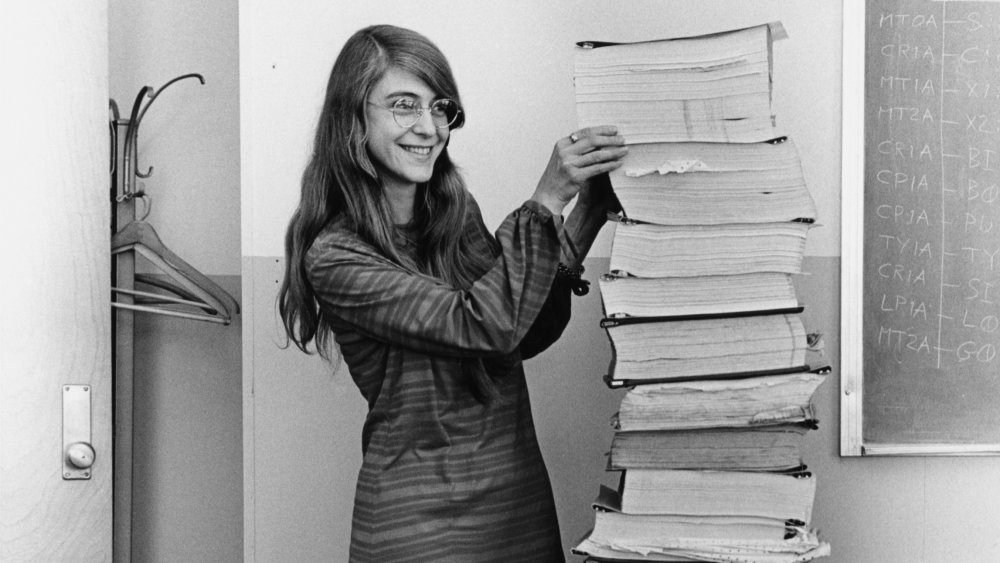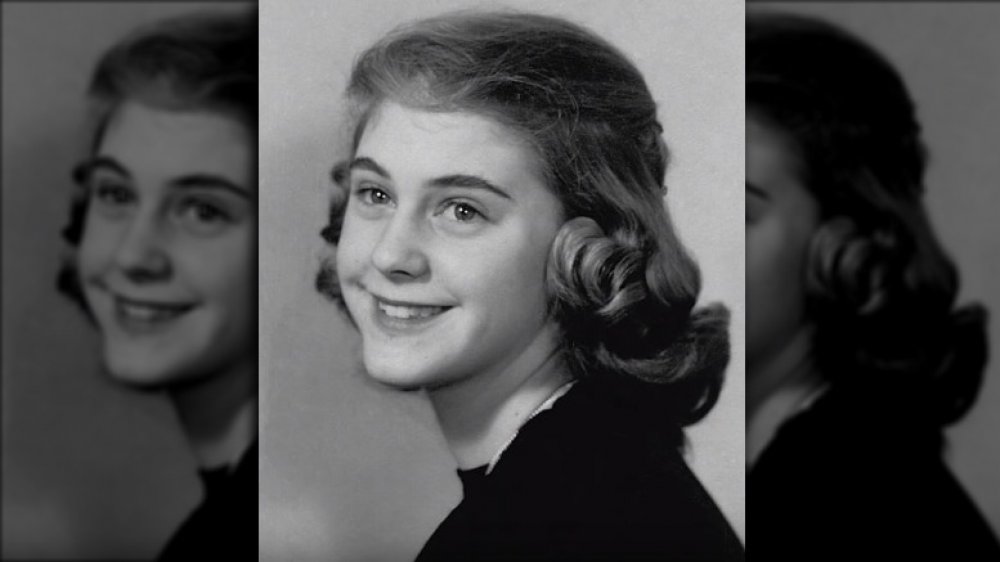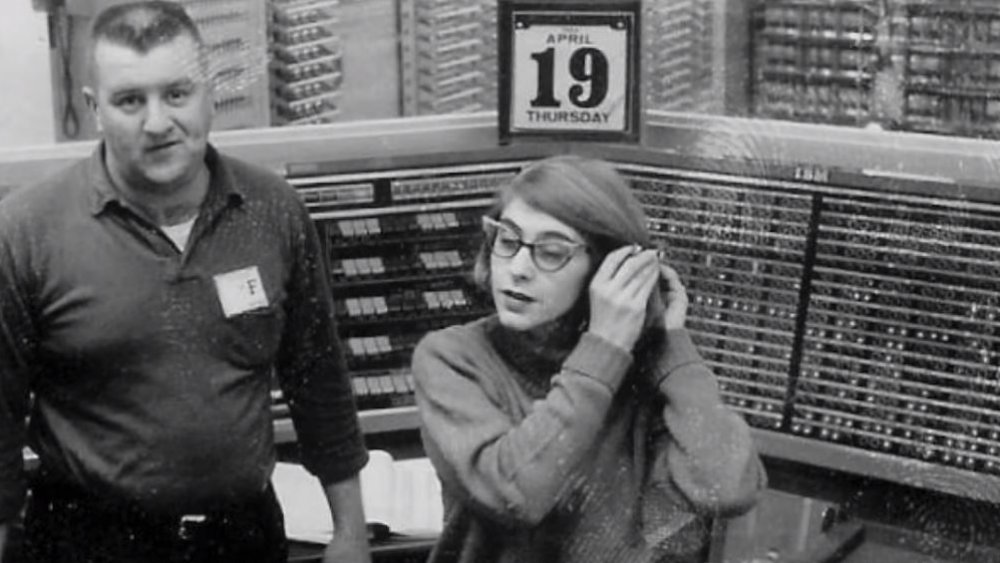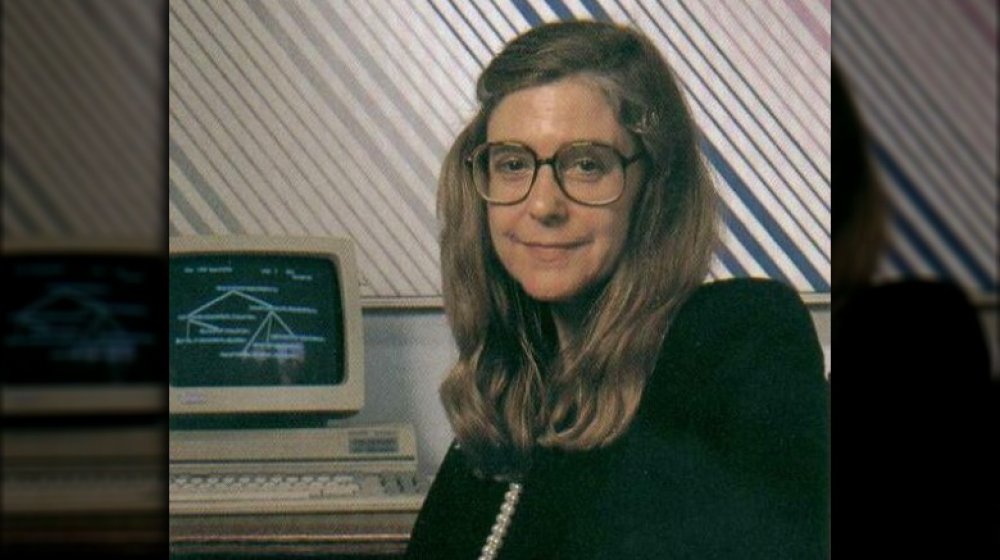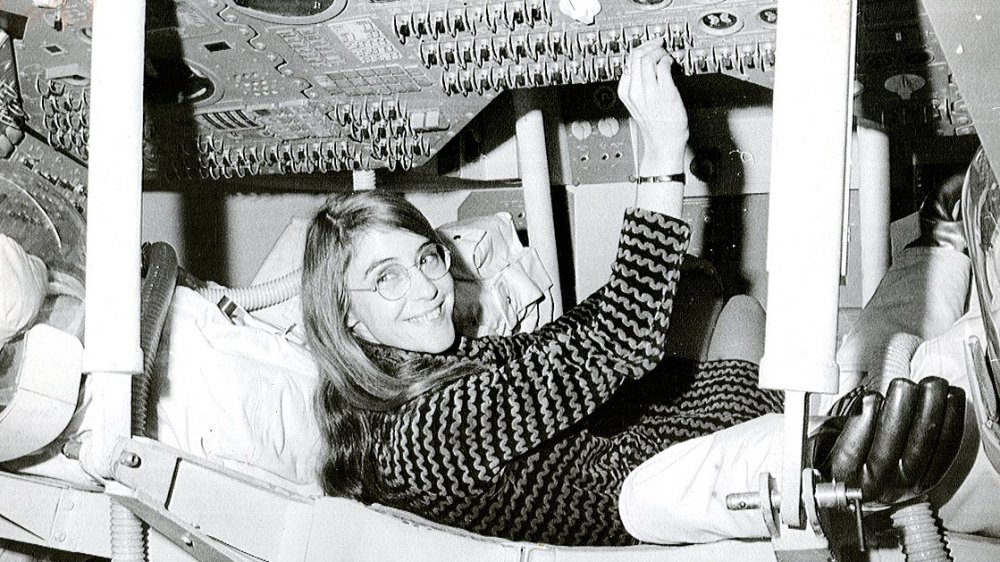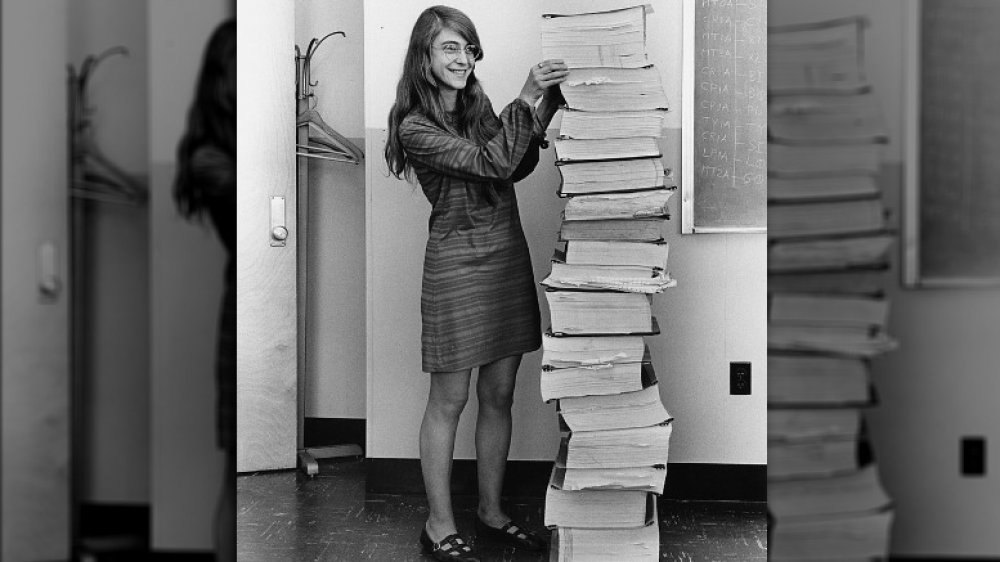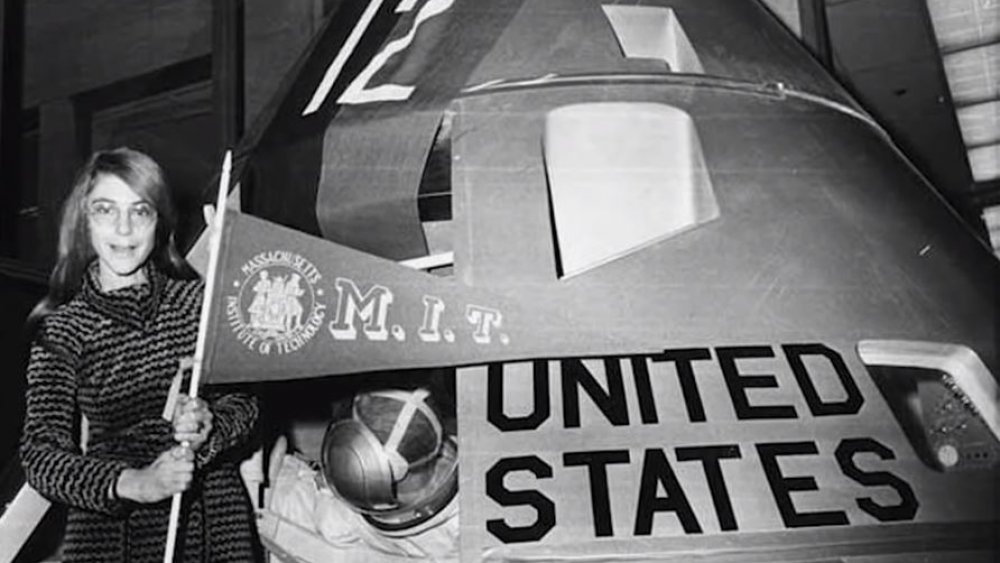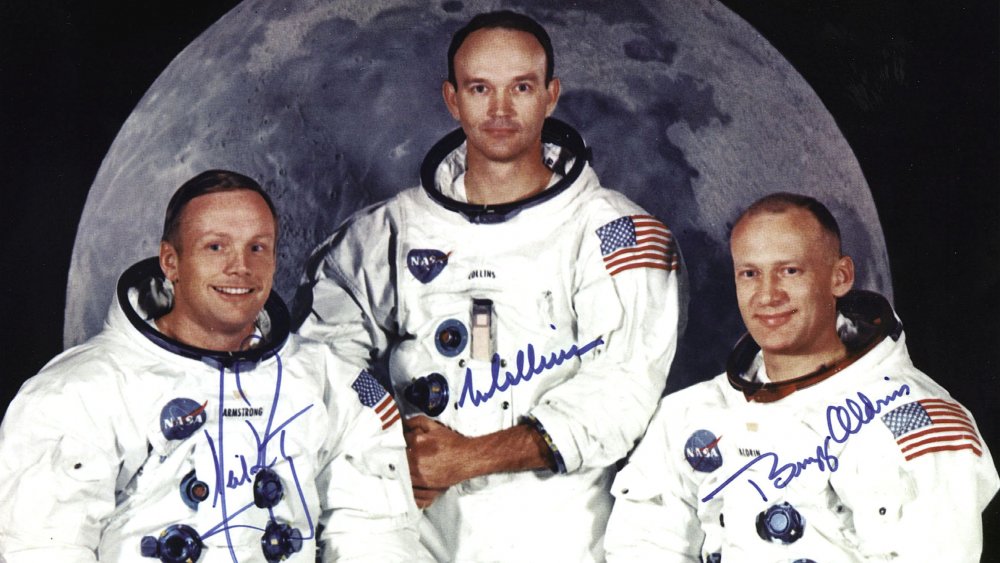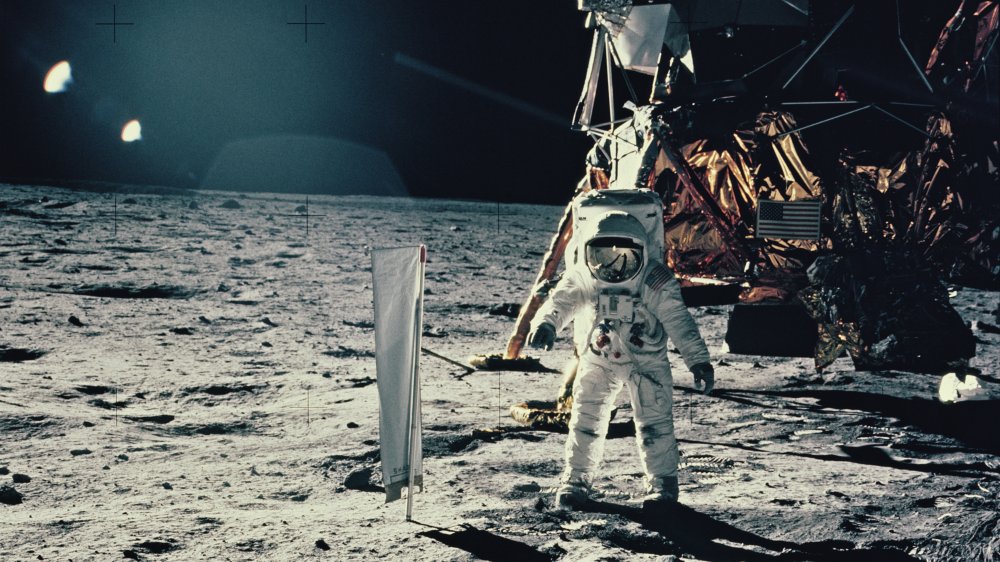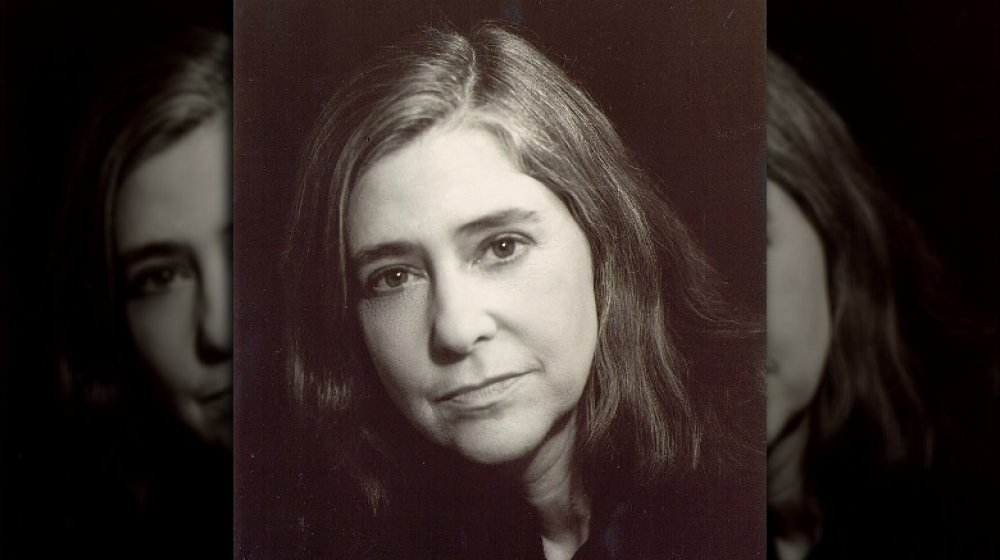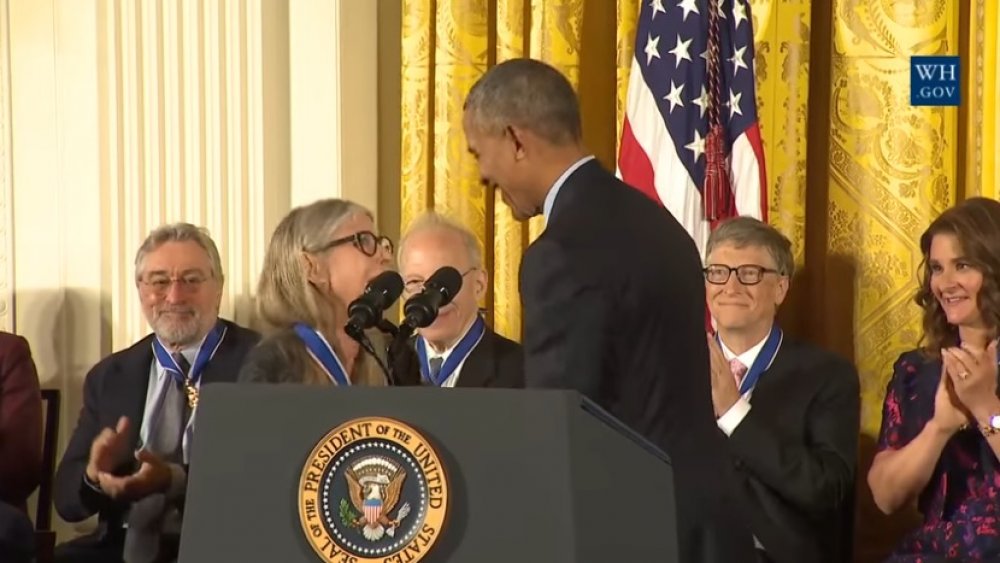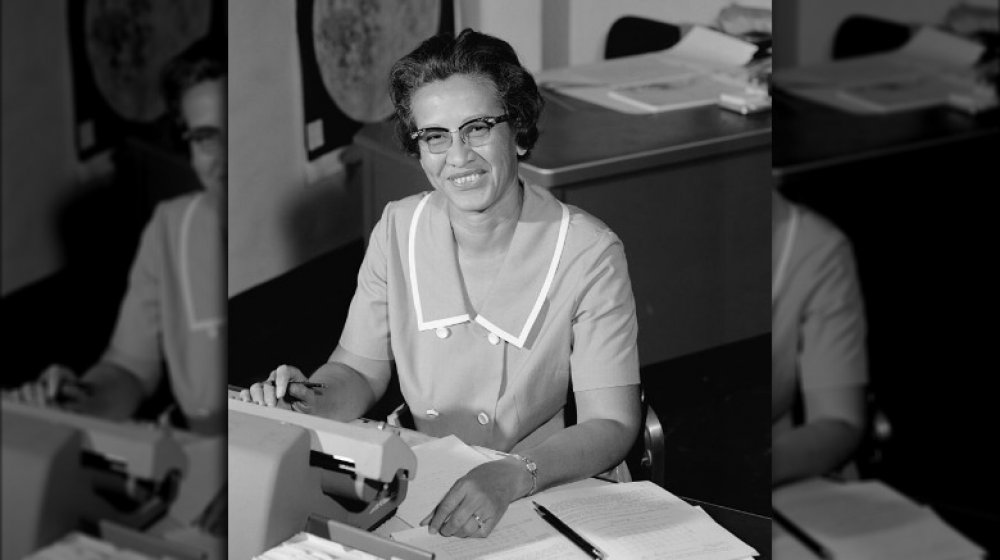The Untold Truth Of The Woman Who Took America To The Moon
When humankind first landed on the moon, the names of Neil Armstrong, Buzz Aldrin, and Michael Collins were forever etched into the tablet of history. However, while nothing could ever diminish the bravery of these guys — seriously, can you imagine strapping yourself into a tin can and getting hurtled into outer space, with no guarantee of survival? — what's not often mentioned is the thousands of other dedicated folks, working on the Apollo 11 mission from back at home, who transformed an impossible dream into a trivia fact that kids learn in first grade.
One of the most important minds behind the lunar landing, as it happens, was a young woman named Margaret Hamilton. You might've seen the above photo of her standing next to a stack of "code" as tall as she is, but her story runs far deeper than that. A brilliant mathematician, an ambitious overachiever, a dedicated mother, and the world's first software engineer, Hamilton worked night and day to make Apollo 11 a success, forever changing the course of history.
Margaret Hamilton loved math from the very beginning
Margaret Heafield was one of those super-smart whiz kids who actually loved math, and wanted to make a career of it. An Indiana native, according to Encyclopedia Britannica, Heafield studied both mathematics and philosophy at Earlham College, in Richmond, during the mid-fifties. While at Earlham, she was celebrated as the homecoming queen, according to the Boston Globe, and it was here that she met and married the student body president, James Cox Hamilton.
Bright, creative, and academically gifted, Margaret was driven to continue her education — but the world pulled her in other directions. She swiftly became the breadwinner of her family, as explained by the Vintage News, by working as a high school math teacher. This was probably never supposed to be anything more than a temporary job: as soon as the couple relocated to New England, so that her husband could study law at Harvard University, she set her sights on studying abstract mathematics at Boston's Brandeis University. Hamilton soon pivoted away from her academic plans, however, and instead took a job at the prestigious Massachusetts Institute of Technology, better known as MIT.
This, in the end, proved to be a monumental decision. It was her work at MIT that would take her to the skies ... and soon, high above them.
Onward, to the moon!
Margaret Hamilton's early MIT days involved meteorology, according to the New England Historical Society, as she programmed software for predicting the weather. Keep in mind, as the Vintage News points out, that during these years, the term "software" didn't yet exist. Programming wasn't a respected skill. There were no college courses. No rule book. This meant Hamilton's approach was, by sheer necessity, largely autodidactic. After a year of proving herself at MIT, the U.S. military took note, and Hamilton was hired onto the Semi-Automatic Ground Environment project, or SAGE. Hamilton worked as a designer for this anti-aircraft defense system for the next three years.
But Hamilton's SAGE work opened the door for a different joint project between MIT and a government agency. This time, the agency was NASA.
See, by 1963, NASA was pushing hard to make John F. Kennedy's lunar dreams a reality. The Apollo project was unprecedented in scope, though, and they had enlisted MIT's Charles Stark Draper lab to develop the software. Along came Margaret Hamilton, who swiftly applied for a job, and snagged it. As the moon project got underway, this twenty-something working woman and mother — in the 1960s, no less! — rose through the ranks, eventually becoming the director of programming for both the Apollo and Skylab projects. Badass? You bet, and her accomplishments only grew from there.
Margaret Hamilton was the world's first software engineer
These days, you hear the term "software engineer" thrown about nearly every day, particularly if you live near Silicon Valley. It has become one of the most lauded professions on Earth. Parents across the world nod affirmatively if their kid chooses it as a college major, since that's one job that's never going to go away. Guess what, though? Not only was Margaret Hamilton the first software engineer in the world, but she literally invented the term.
Hamilton came up with the description while she was working on the Apollo spacecraft's guidance and navigation system, according to the IEEE Computer Society, as part of her overall effort to establish her work as a legitimate profession, necessary for major processes like ... you know, shooting human beings into space. At the time, she says, her peers mocked the perceived grandiosity of the label, and according to the Smithsonian, people accused her of exaggerating the importance of her work. In retrospect, needless to say, all these jokers look like fools. Hamilton paved the way for what is now one of the most sought after professions in the modern era: according to the U.S. Bureau of Labor Statistics, software engineer careers have a growth prediction of 17 percent from 2014 to 2024. Who's laughing now?
Margaret Hamilton was a radical changemaker, way ahead of her time
As a brilliant, young, independent woman who thrived when supervising a team of male engineers and was raising a daughter at the same time, Margaret Hamilton's story would seem progressive enough today. In the context of the sixties, though, she was downright radical. Far from being the sort of domestic housewife that society condoned at the time, as explained by Wired, Hamilton was a dedicated employee who worked long days and longer nights, programming what would one day be the command module computer aboard the Apollo spacecraft. On the weekends and evenings, she'd bring her 4-year-old daughter Lauren to the lab, letting her see the equipment, hang out, and/or sleep in her office while she worked. Hamilton was detail-oriented to a T, and thorough, once rushing back to the lab after a late-night party just to correct a coding error that occurred to her sometime between drinks. Hamilton also openly combated sexist policies that she believed were unfair, according to Time, standing up for her female coworkers and getting rules changed.
When Hamilton first got promoted to her position, as she later told the Guardian, the upper-level bosses expressed concern that — despite her clear skills, passion, and knowledge — the men working underneath her "might rebel" at the notion of taking orders from a woman. That didn't happen. Hamilton's leadership proved integral to developing the moon mission software, and she credits the entire team for working side by side as equals, from beginning to end.
Software engineering was the wild west, and coding was way harder than it is today
Back when Margaret Hamilton was working on Apollo 11, even those antiquated old MS-DOS screens that you might associate with the term "coding" (you know, depending your age ... ) were still years away. Everything was new. Rules didn't exist. As Hamilton once put it, according to Wired, "It was like the Wild West."
The code that Hamilton wrote and worked with is, perhaps, best represented by the now-iconic image of her above, where she's standing next to a stack as tall as she is. Now, to be clear, this photo wasn't some chintzy exaggeration of the type you'd see on Instagram today: that's really her code, crazy as it might sound. And when Hamilton coded, she had to physically punch holes into cards, have them processed, and then they'd be shipped to a nearby facility. As Vox explains, the women working at this facility were seamstresses who wove programs together — by hand! — using copper wires roped into metal cores, to represent the 1s and 0s of binary code. This cord rope memory was often referred to as LOL memory, standing for "little old lady," and ... oh, wait, that's where LOL came from?
Anyhow, this was insanely hard work for everyone involved, and because nobody had ever touched the moon before, the stakes were high. As Hamilton says today, according to MIT News, "There was no choice but to be pioneers." Every working day meant solving new problems with innovative solutions.
Humans on the moon? Thank Margaret Hamilton
When it comes to Apollo 11's software, Margaret Hamilton and her team wrote the book. And without that software, not to mention Hamilton's well-documented insistence on rigorous testing, humans would've never reached the moon safely, according to NASA. Even before Armstrong and company sailed into the stars, Hamilton's work had already saved lives, according to Wired: one day, earlier in the development process, Hamilton had let her daughter play with the command module simulator, and watched as Lauren "crashed" the vessel by accidentally initiating a prelaunch program called P01. In response, Hamilton wanted to input code to prevent such a P01 crash from happening in real life, but NASA resisted — arguing that their astronauts were way too perfect to replicate the errors of a child (cough, cough). Overruled, Hamilton still made sure to include a program note for the astronauts to see, telling them what to do if this mess-up occurred in action.
Surely enough, when the Apollo 8 launched in 1968, an astronaut accidentally activated P01, replicating Lauren's error, and wiping out all the data needed to bring the astronauts home from space. Big whoops. However, thanks to Hamilton's foresight, the problem was quickly corrected, and the astronauts were rescued within hours. After that, NASA was a bit more trusting of Hamilton's advice, and even after the famous Apollo 11 moon crew finished their mission, her bug-free guidance software was later used for both Skylab and the Space Shuttle.
Margaret Hamilton's work proved itself at a pivotal moment
Apollo 8 wasn't the last time that Margaret Hamilton saved everybody's necks, though. The historic Apollo 11 mission itself came within inches of disaster on the fateful day of July 20th, 1969 ... only for the astronauts to, once again, be saved by her fastidious programming. See, right before Armstrong and Aldrin could land on the moon, according to Wired, the astronauts got bombarded with warning alerts aboard their lunar module, the Eagle. These error messages were occurring because the computer was freaking out, overwhelming itself with unneeded calculations, error detection messages, and more, which — if Hamilton hadn't anticipated this beforehand — could have resulted in the tragic, fatal end of the mission. The clock was ticking, the Eagle's fuel was running out, according to the Smithsonian, and the astronauts' faulty checklist had caused them to set an important switch incorrectly.
Well, as you know today, "the Eagle" landed, and this successful historical event occurred because Margaret Hamilton had planned ahead. Her thorough, details-oriented program made it so that when the computer system got overwhelmed, it shed all the unnecessary tasks, and prioritized the goal of landing on the moon ... which, obviously, it did with aplomb.
For Margaret Hamilton, it was only after the moon landing when reality set in
While the Eagle was propelling toward the lunar surface, Margaret Hamilton was as focused as ever. She was right there in mission control, from MIT, watching the entire thing go down. It was a historic moment. The peak achievement of human science. However, while Hamilton was certain paying attention, it took her a moment to process the sheer historicity of the wondrous event that she'd helped propel forward. While she felt an immense relief, as she later recalled in a 2017 Makers interview, "I was not concentrating on the mission, per se. I was concentrating on the software." Fair enough.
Of course, it didn't take too long for this calming relief to be replaced by the enthusiastic amazement that soon overtook everyone across the planet. Today, she describes feeling overwhelmed by the realization that everything had pulled together into a triumphant success. Her thoughts at the time, as she puts it, were along the lines of, "My God. Look what happened. We did it. It worked. It was exciting."
Margaret Hamilton, tech entrepreneur
So, once you've helped land humankind on the moon, and become an MIT director at such a young age, what do you do next?
This was the puzzle that Margaret Hamilton now faced, and her answer was, simply enough, to continue spurring software engineering into the future as a tech entrepreneur, by applying her philosophy of error prevention (also called DBTF, or Development Before the Fact) to a wider scale. After departing from NASA in the seventies, according to Encyclopedia Britannica, Hamilton co-founded a company called Higher Order Software, followed by the creation of Hamilton Technologies just a decade later. Her post-Apollo work, according to the New Stack, focused on the development of what she called the Universal Systems Language, which is a standardized process for recording software errors, so that problems can be caught early and corrected before they cause catastrophic results. Good stuff. Obviously, this is an area where she can absolutely be considered the expert, given what happened on both Apollo 8 and Apollo 11.
As recorded by Time, Hamilton believes that software reliability is the key to future space technology, and hey, it's hard to argue with that.
Decades later, Margaret Hamilton received the awards and prestige she deserved
Believe it or not, it took until 2003 (!) for NASA to formally recognize Margaret Hamilton's achievements in a public setting, but when they did, she was granted the NASA Exceptional Space Act Award. As stated by NASA Administrator Sean O'Keefe, "The Apollo flight software Ms. Hamilton and her team developed was truly a pioneering effort. The concepts she and her team created became the building blocks for modern 'software engineering.' It's an honor to recognize Ms. Hamilton for her extraordinary contributions to NASA."
About time, eh? Thankfully, the 21st century has seen Hamilton's star rise. Popular culture, in general, has become more aware of the contribution of women to the space program, and Hamilton's photo in particular — yes, you know the one — has gone viral, turning her into a major role model. In November of 2016, according to the Verge, then-President Barack Obama bestowed upon Hamilton the Presidential Medal of Freedom, the highest civilian award in the United States, alongside other major figures such as Michael Jordan, Ellen DeGeneres, and Bill and Melinda Gates.
The tributes didn't end there, though. To commemorate the 50th anniversary of the Apollo 11 moon landing in 2019, CNN reports that Google put together an elaborate array of 107,000 mirrors across the Mojave Desert, extending 1.4 square miles. This glass display was carefully positioned to reflect the light from direct moonbeams, and shine the enduring image of Margaret Hamilton's face back up into the night sky.
Margaret Hamilton was one of many women who brought humans to outer space
Apollo 11 was a group effort, which required numerous people to work together, in unison, to make this dream a reality ... and many of NASA's unsung heroes, in fact, were female. As History explains, back in the mid-20th century, the term "computer" usually referred to a job position for women, rather than a machine. These computers performed complex mathematical equations by hand, and the complex programs created by women like Katherine Johnson (pictured above), Sue Finley, and Dorothy Vaughan paved the way for the Apollo missions, the Mars Rover, and more.
Unfortunately, according to the Los Angeles Times, computers received less status and lower pay than the male engineers. Recently, their stories have resurfaced, thanks to accounts like Margot Lee Shetterly's book Hidden Figures, and its 2016 film adaptation. As time goes on, it becomes increasingly clear that the history of space travel is deeply entrenched with the history of female mathematicians, scientists, and programmers. As for Margaret Hamilton, the first software engineer? In spurring on more young women who might one day follow her footsteps into STEM careers, according to Futurism, she advises them to stay true to themselves. "Never let fear get in the way!," she says. "Don't be afraid to continue when things appear to be impossible, even when the so-called 'experts' say it is impossible. Don't be afraid to stand alone, to be different, to be wrong, to make and admit mistakes, for only those who dare to fail greatly can ever achieve greatly."
